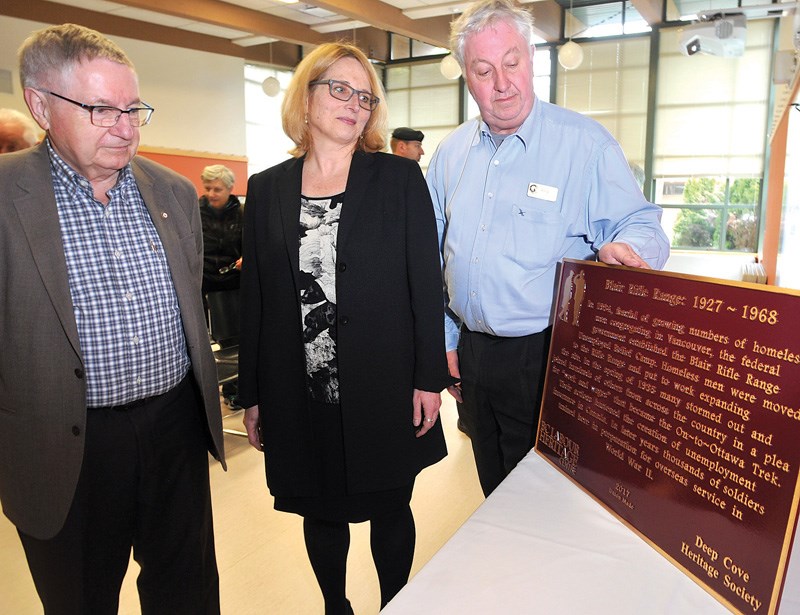“What’s the deal with this rifle range that’s here?”
It started with this innocuous question, asked by a neighbour to Blueridge resident Donna Sacuta one day in 2014.
The neighbour followed this up with some additional queries: “‘How come we can’t do anything on it? How come the trail doesn’t go anywhere?’”
The questions piqued Sacuta’s interest, to say the least, and she began to take a closer look at what’s called the Blair Rifle Range, a large stretch of land nestled between Northlands Golf Course and McCartney Creek Park along Mount Seymour Parkway.
“I said, ‘That’s a really good question. I want to find out too.’ I just started digging around … Started to find a little bit of information and it just really piqued my interest and it fit in with my sort of academic interests in terms of labour history,” Sacuta says.
She started writing a research paper, which was completed in 2015 and looks at the untold story of the rifle range and its relationship to Canadian history.
She received a heritage award from the District of North Vancouver last year for her historical research on the rifle range.
At Parkgate Community Centre on March 31, a plaque was unveiled by the B.C. Labour Heritage Centre and Deep Cove Heritage Society that pays homage to the rifle range’s role in Canada’s formative history, something Sacuta is passionate about.
“It signifies a lot of different periods in Canadian history,” Sacuta says. “It has a connection to the Depression and what was done with single, unemployed men in Canada during the Depression – putting them in work camps.”
Canada, like much of the Western world, was thrust into catastrophic economic downturn in 1929. The crisis resulted in tough times for all facets of Canadian society, including its military.
Canada’s department of defence formally opened the Blair Rifle Range in 1930, coinciding with a period when the unemployment of single men was alarmingly high. This was during a period before comprehensive social assistance and welfare programs were in place and many of these men found themselves ineligible to receive relief payments.
According to Sacuta’s research, when the government became compelled to take action over the high unemployment of single men across Canada, the department of defence was tapped with managing a national scheme of unemployed relief camps.
The military saw an opportunity to get unemployed men working by having them partake in potentially important army construction projects. More than 60,000 men were placed in camps around B.C., including ones where they were forced to help build, expand and maintain military rifle ranges.
The Blair Rifle Range was the largest rifle range construction project the department undertook during the course of its work relief programs.
Due to the often harsh, isolated conditions of the work the men were subjected to, a political radicalism began to develop among many of the workers, leading to the formation of early social movements.
“The Depression in Canada left a real legacy of protest groups, activist groups, activism and national social programs,” Sacuta says.
She says many of the men from these camps, including ones at the Blair Rifle Range, went on to participate in the era-defining On-to-Ottawa Trek.
“When they went on strike in 1935 and tried to take their case to the government in Ottawa and were stopped in Regina, many of those men went on to continue to be active in advocating for social programs in Canada after the war,” she says.
The history of the Blair Rifle Range extends beyond Canada’s Depression-era period and into the Second World War.
“There was a strong military presence in the Seymour area leading up to the Second World War, and during the war and after, because it was the main training facility for all the regiments who were going to fight in the war,” Sacuta says.
She says, for example, that newspaper clippings she unearthed from the era show that regiments from places like Edmonton and Medicine Hat, visited the rifle range for training purposes.
“It was the only 1,000-yard range in the Lower Mainland, and I guess 1,000 yards is big by military rifle range standards,” she says.
Over time, regimental associations also made sure to use the rifle range for sharpshooting tournaments. In 1968 the Canadian Mortgage and Housing Corporation took the land over from the military. Sacuta says the idea was for housing to be constructed on it, but nothing ever really materialized, even though over the decades both CMHC and the province talked about developing there. In the late 1990s, North Vancouver District rezoned it so that couldn’t happen.
“There was a real push against development in that area,” Sacuta says. “They wanted it retained as forest.”
The five parcels of land where part of the former rifle range sits entails more than 600 acres, some of which is used today by North Shore trail hikers.
“You can still see where the firing berms were and are. You can still see where the buildings were. … Ultimately, I would like that site preserved as a very important historical site,” she says.
Since being first asked that innocent question by her neighbour three years ago, Sacuta has done her research, written her paper and collaborated with various historical and heritage organizations.
She was recently named as the executive director of the B.C. Labour Heritage Centre for her tireless efforts in promoting local history. Sacuta’s thrilled the commemorative plaque, a partnership with the Deep Cove Heritage Society, will soon be formally installed near the old rifle range at the corner of Mount Seymour Parkway and Northlands Drive.
“It serves as a reminder to us of what’s happened in the past,” she says.



